VOLKSWAGEN TIGUAN 2017 Owner´s Manual
Manufacturer: VOLKSWAGEN, Model Year: 2017, Model line: TIGUAN, Model: VOLKSWAGEN TIGUAN 2017Pages: 341, PDF Size: 9.14 MB
Page 281 of 341
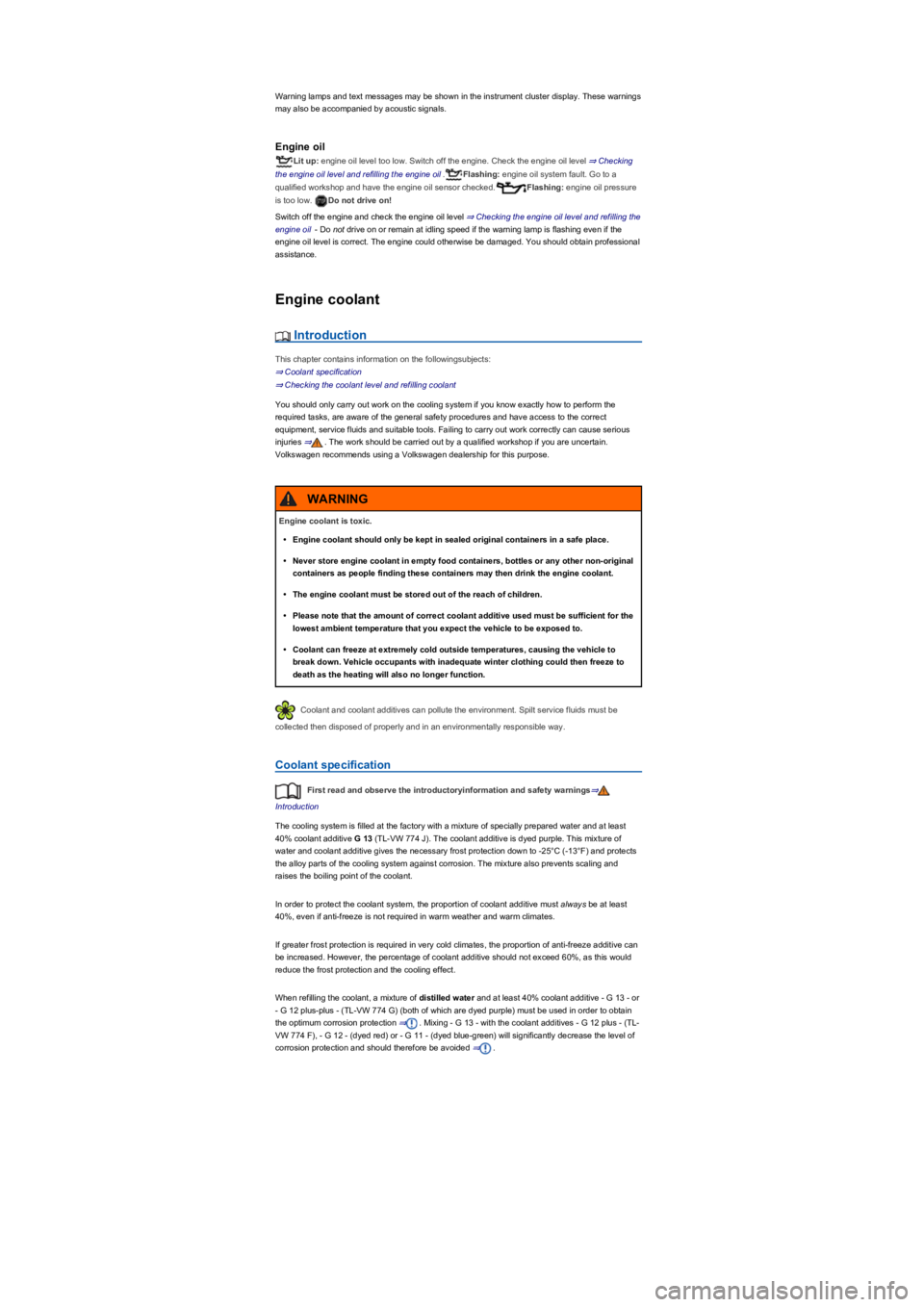
Warning lamps and text messages may be shown in the instrument cluster display. These warnings
may also be accompanied by acoustic signals.
Engine oil
Lit up: engine oil level too low. Switch off the engine. Check the engine oil level ⇒ Checking
the engine oil level and refilling the engine oil.Flashing: engine oil system fault. Go to a
qualified workshop and have the engine oil sensor checked.Flashing: engine oil pressure
is too low. Do not drive on!
Switch off the engine and check the engine oil level ⇒ Checking the engine oil level and refilling the
engine oil - Do not drive on or remain at idling speed if the warning lamp is flashing even if the
engine oil level is correct. The engine could otherwise be damaged. You should obtain professional
assistance.
Engine coolant
Introduction
This chapter contains information on the followingsubjects:
⇒ Coolant specification
⇒ Checking the coolant level and refilling coolant
You should only carry out work on the cooling system if you know exactly how to perform the
required tasks, are aware of the general safety procedures and have access to the correct
equipment, service fluids and suitable tools. Failing to carry out work correctly can cause serious
injuries ⇒. The work should be carried out by a qualified workshop if you are uncertain.
Volkswagen recommends using a Volkswagen dealership for this purpose.
Coolant and coolant additives can pollute the environment. Spilt service fluids must be
collected then disposed of properly and in an environmentally responsible way.
Coolant specification
First read and observe the introductoryinformation and safety warnings⇒
Introduction
The cooling system is filled at the factory with a mixture of specially prepared water and at least
40% coolant additive G 13 (TL-VW 774 J). The coolant additive is dyed purple. This mixture of
water and coolant additive gives the necessary frost protection down to -25°C (-13°F) and protects
the alloy parts of the cooling system against corrosion. The mixture also prevents scaling and
raises the boiling point of the coolant.
In order to protect the coolant system, the proportion of coolant additive must always be at least
40%, even if anti-freeze is not required in warm weather and warm climates.
If greater frost protection is required in very cold climates, the proportion of anti-freeze additive can
be increased. However, the percentage of coolant additive should not exceed 60%, as this would
reduce the frost protection and the cooling effect.
When refilling the coolant, a mixture of distilled water and at least 40% coolant additive - G 13 - or
- G 12 plus-plus - (TL-VW 774 G) (both of which are dyed purple) must be used in order to obtain
the optimum corrosion protection ⇒. Mixing - G 13 - with the coolant additives - G 12 plus - (TL-
VW 774 F), - G 12 - (dyed red) or - G 11 - (dyed blue-green) will significantly decrease the level of
corrosion protection and should therefore be avoided ⇒.
Engine coolant is toxic.
•Engine coolant should only be kept in sealed original containers in a safe place.
•Never store engine coolant in empty food containers, bottles or any other non-original
containers as people finding these containers may then drink the engine coolant.
•The engine coolant must be stored out of the reach of children.
•Please note that the amount of correct coolant additive used must be sufficient for the
lowest ambient temperature that you expect the vehicle to be exposed to.
•Coolant can freeze at extremely cold outside temperatures, causing the vehicle to
break down. Vehicle occupants with inadequate winter clothing could then freeze to
death as the heating will also no longer function.
WARNING
Page 282 of 341
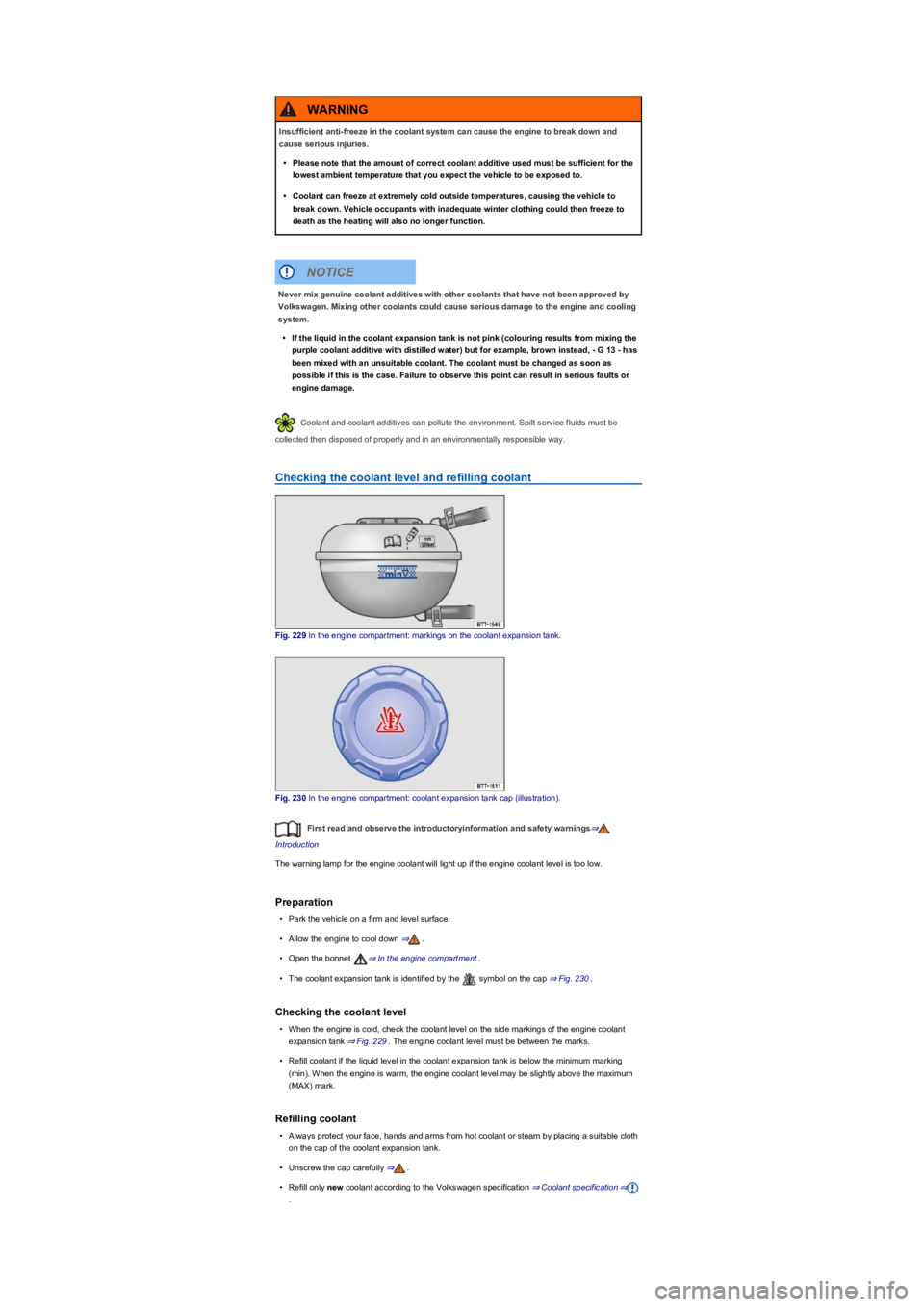
Coolant and coolant additives can pollute the environment. Spilt service fluids must be
collected then disposed of properly and in an environmentally responsible way.
Checking the coolant level and refilling coolant
Fig. 229 In the engine compartment: markings on the coolant expansion tank.
Fig. 230 In the engine compartment: coolant expansion tank cap (illustration).
First read and observe the introductoryinformation and safety warnings⇒
Introduction
The warning lamp for the engine coolant will light up if the engine coolant level is too low.
Preparation
•Park the vehicle on a firm and level surface.
•Allow the engine to cool down ⇒.
•Open the bonnet ⇒ In the engine compartment.
•The coolant expansion tank is identified by the symbol on the cap ⇒ Fig. 230.
Checking the coolant level
•When the engine is cold, check the coolant level on the side markings of the engine coolant
expansion tank ⇒ Fig. 229. The engine coolant level must be between the marks.
•Refill coolant if the liquid level in the coolant expansion tank is below the minimum marking
(min). When the engine is warm, the engine coolant level may be slightly above the maximum
(MAX) mark.
Refilling coolant
•Always protect your face, hands and arms from hot coolant or steam by placing a suitable cloth
on the cap of the coolant expansion tank.
•Unscrew the cap carefully ⇒.
•Refill only new coolant according to the Volkswagen specification ⇒ Coolant specification⇒
.
Insufficient anti-freeze in the coolant system can cause the engine to break down and
cause serious injuries.
•Please note that the amount of correct coolant additive used must be sufficient for the
lowest ambient temperature that you expect the vehicle to be exposed to.
•Coolant can freeze at extremely cold outside temperatures, causing the vehicle to
break down. Vehicle occupants with inadequate winter clothing could then freeze to
death as the heating will also no longer function.
WARNING
Never mix genuine coolant additives with other coolants that have not been approved by
Volkswagen. Mixing other coolants could cause serious damage to the engine and cooling
system.
•If the liquid in the coolant expansion tank is not pink (colouring results from mixing the
purple coolant additive with distilled water) but for example, brown instead, - G 13 - has
been mixed with an unsuitable coolant. The coolant must be changed as soon as
possible if this is the case. Failure to observe this point can result in serious faults or
engine damage.
NOTICE
Page 283 of 341
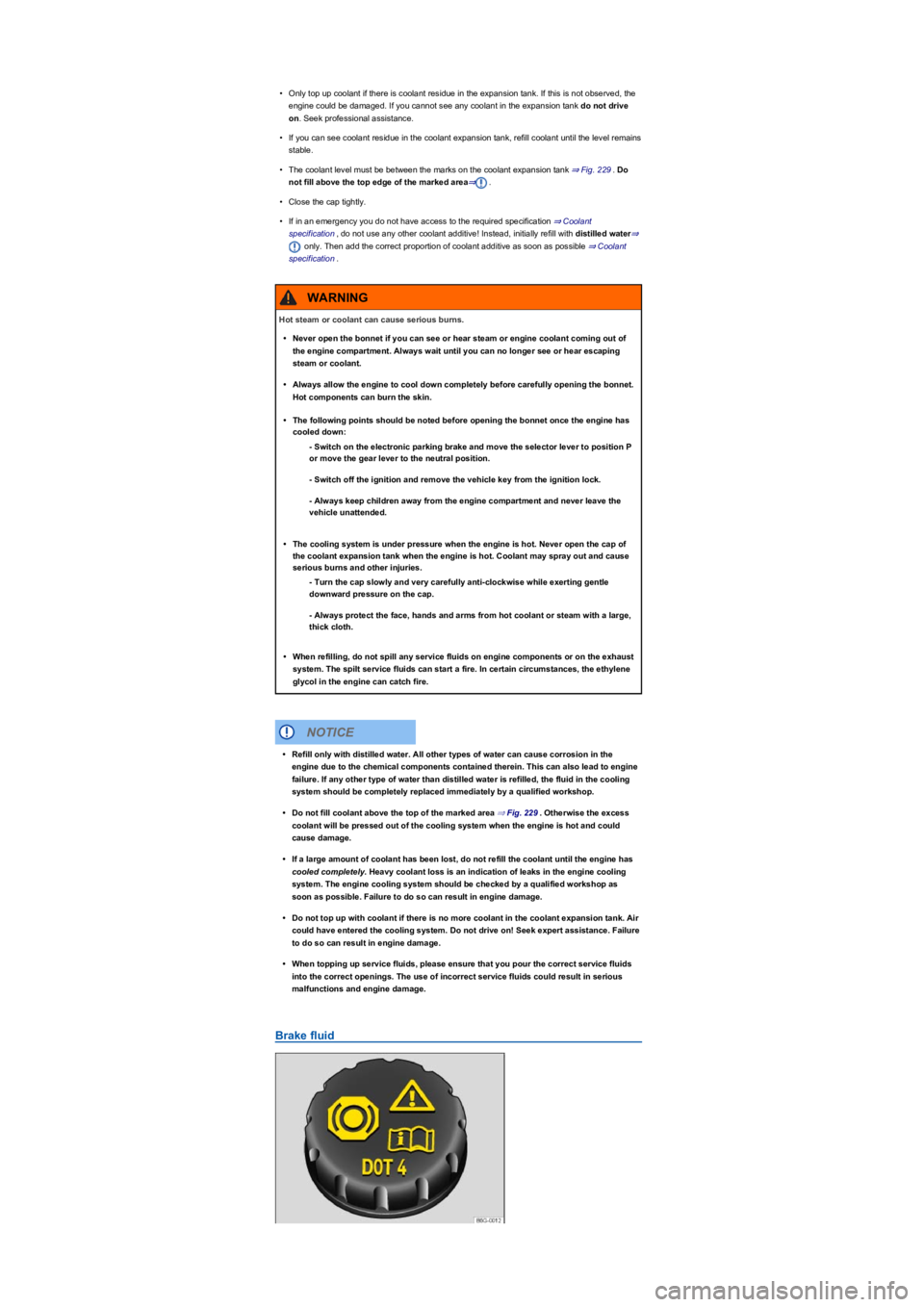
•Only top up coolant if there is coolant residue in the expansion tank. If this is not observed, the
engine could be damaged. If you cannot see any coolant in the expansion tank do not drive
on. Seek professional assistance.
•If you can see coolant residue in the coolant expansion tank, refill coolant until the level remains
stable.
•The coolant level must be between the marks on the coolant expansion tank ⇒ Fig. 229. Do
not fill above the top edge of the marked area⇒.
•Close the cap tightly.
•If in an emergency you do not have access to the required specification ⇒ Coolant
specification, do not use any other coolant additive! Instead, initially refill with distilled water⇒
only. Then add the correct proportion of coolant additive as soon as possible ⇒ Coolant
specification.
Brake fluid
Hot steam or coolant can cause serious burns.
•Never open the bonnet if you can see or hear steam or engine coolant coming out of
the engine compartment. Always wait until you can no longer see or hear escaping
steam or coolant.
•Always allow the engine to cool down completely before carefully opening the bonnet.
Hot components can burn the skin.
•The following points should be noted before opening the bonnet once the engine has
cooled down:
- Switch on the electronic parking brake and move the selector lever to position P
or move the gear lever to the neutral position.
- Switch off the ignition and remove the vehicle key from the ignition lock.
- Always keep children away from the engine compartment and never leave the
vehicle unattended.
•The cooling system is under pressure when the engine is hot. Never open the cap of
the coolant expansion tank when the engine is hot. Coolant may spray out and cause
serious burns and other injuries.
- Turn the cap slowly and very carefully anti-clockwise while exerting gentle
downward pressure on the cap.
- Always protect the face, hands and arms from hot coolant or steam with a large,
thick cloth.
•When refilling, do not spill any service fluids on engine components or on the exhaust
system. The spilt service fluids can start a fire. In certain circumstances, the ethylene
glycol in the engine can catch fire.
WARNING
•Refill only with distilled water. All other types of water can cause corrosion in the
engine due to the chemical components contained therein. This can also lead to engine
failure. If any other type of water than distilled water is refilled, the fluid in the cooling
system should be completely replaced immediately by a qualified workshop.
•Do not fill coolant above the top of the marked area ⇒ Fig. 229. Otherwise the excess
coolant will be pressed out of the cooling system when the engine is hot and could
cause damage.
•If a large amount of coolant has been lost, do not refill the coolant until the engine has
cooled completely. Heavy coolant loss is an indication of leaks in the engine cooling
system. The engine cooling system should be checked by a qualified workshop as
soon as possible. Failure to do so can result in engine damage.
•Do not top up with coolant if there is no more coolant in the coolant expansion tank. Air
could have entered the cooling system. Do not drive on! Seek expert assistance. Failure
to do so can result in engine damage.
•When topping up service fluids, please ensure that you pour the correct service fluids
into the correct openings. The use of incorrect service fluids could result in serious
malfunctions and engine damage.
NOTICE
Page 284 of 341
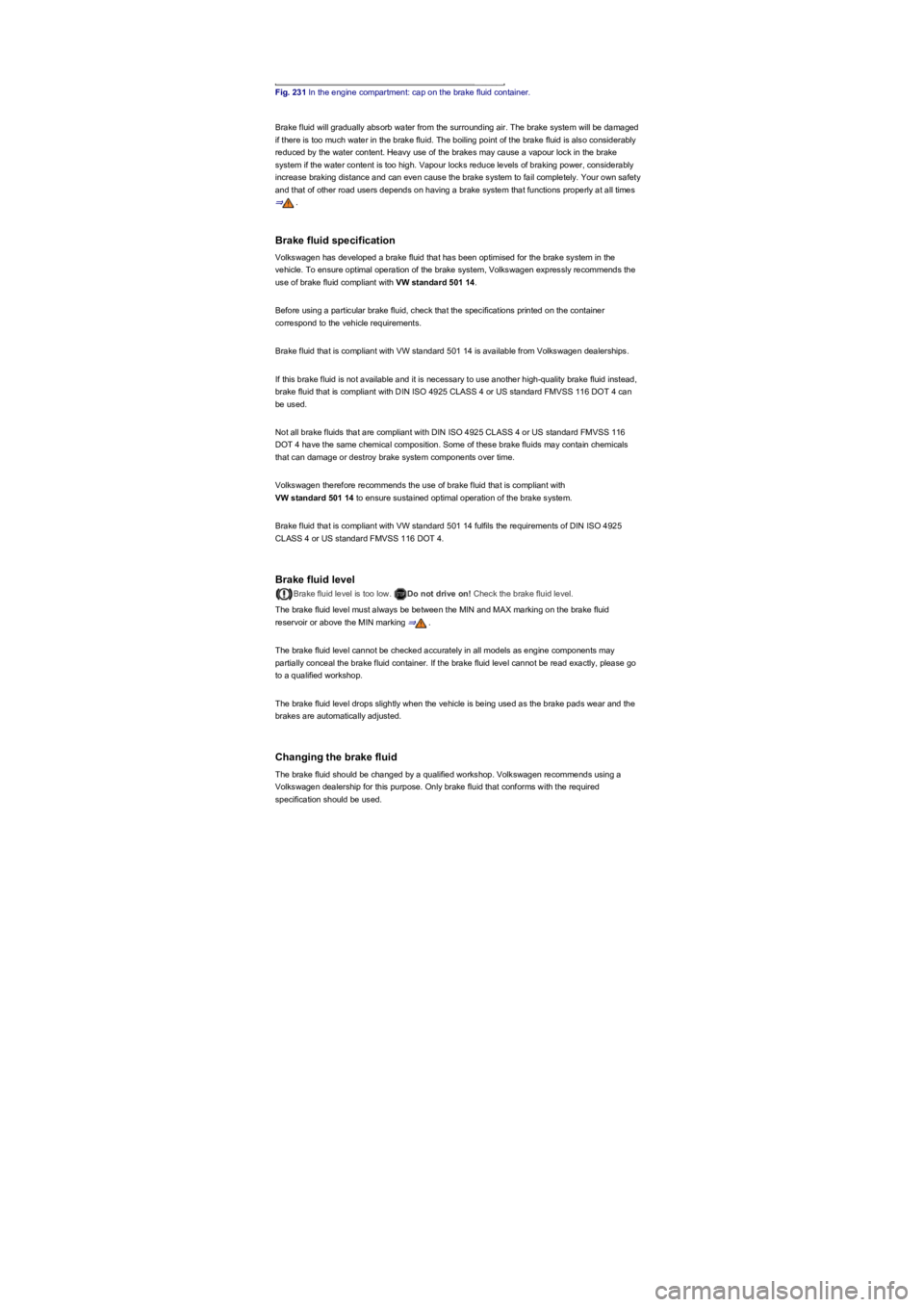
Fig. 231 In the engine compartment: cap on the brake fluid container.
Brake fluid will gradually absorb water from the surrounding air. The brake system will be damaged
if there is too much water in the brake fluid. The boiling point of the brake fluid is also considerably
reduced by the water content. Heavy use of the brakes may cause a vapour lock in the brake
system if the water content is too high. Vapour locks reduce levels of braking power, considerably
increase braking distance and can even cause the brake system to fail completely. Your own safety
and that of other road users depends on having a brake system that functions properly at all times
⇒.
Brake fluid specification
Volkswagen has developed a brake fluid that has been optimised for the brake system in the
vehicle. To ensure optimal operation of the brake system, Volkswagen expressly recommends the
use of brake fluid compliant with VW standard 501 14.
Before using a particular brake fluid, check that the specifications printed on the container
correspond to the vehicle requirements.
Brake fluid that is compliant with VW standard 501 14 is available from Volkswagen dealerships.
If this brake fluid is not available and it is necessary to use another high-quality brake fluid instead,
brake fluid that is compliant with DIN ISO 4925 CLASS 4 or US standard FMVSS 116 DOT 4 can
be used.
Not all brake fluids that are compliant with DIN ISO 4925 CLASS 4 or US standard FMVSS 116
DOT 4 have the same chemical composition. Some of these brake fluids may contain chemicals
that can damage or destroy brake system components over time.
Volkswagen therefore recommends the use of brake fluid that is compliant with
VW standard 501 14 to ensure sustained optimal operation of the brake system.
Brake fluid that is compliant with VW standard 501 14 fulfils the requirements of DIN ISO 4925
CLASS 4 or US standard FMVSS 116 DOT 4.
Brake fluid level
Brake fluid level is too low. Do not drive on! Check the brake fluid level.
The brake fluid level must always be between the MIN and MAX marking on the brake fluid
reservoir or above the MIN marking ⇒.
The brake fluid level cannot be checked accurately in all models as engine components may
partially conceal the brake fluid container. If the brake fluid level cannot be read exactly, please go
to a qualified workshop.
The brake fluid level drops slightly when the vehicle is being used as the brake pads wear and the
brakes are automatically adjusted.
Changing the brake fluid
The brake fluid should be changed by a qualified workshop. Volkswagen recommends using a
Volkswagen dealership for this purpose. Only brake fluid that conforms with the required
specification should be used.
Page 285 of 341
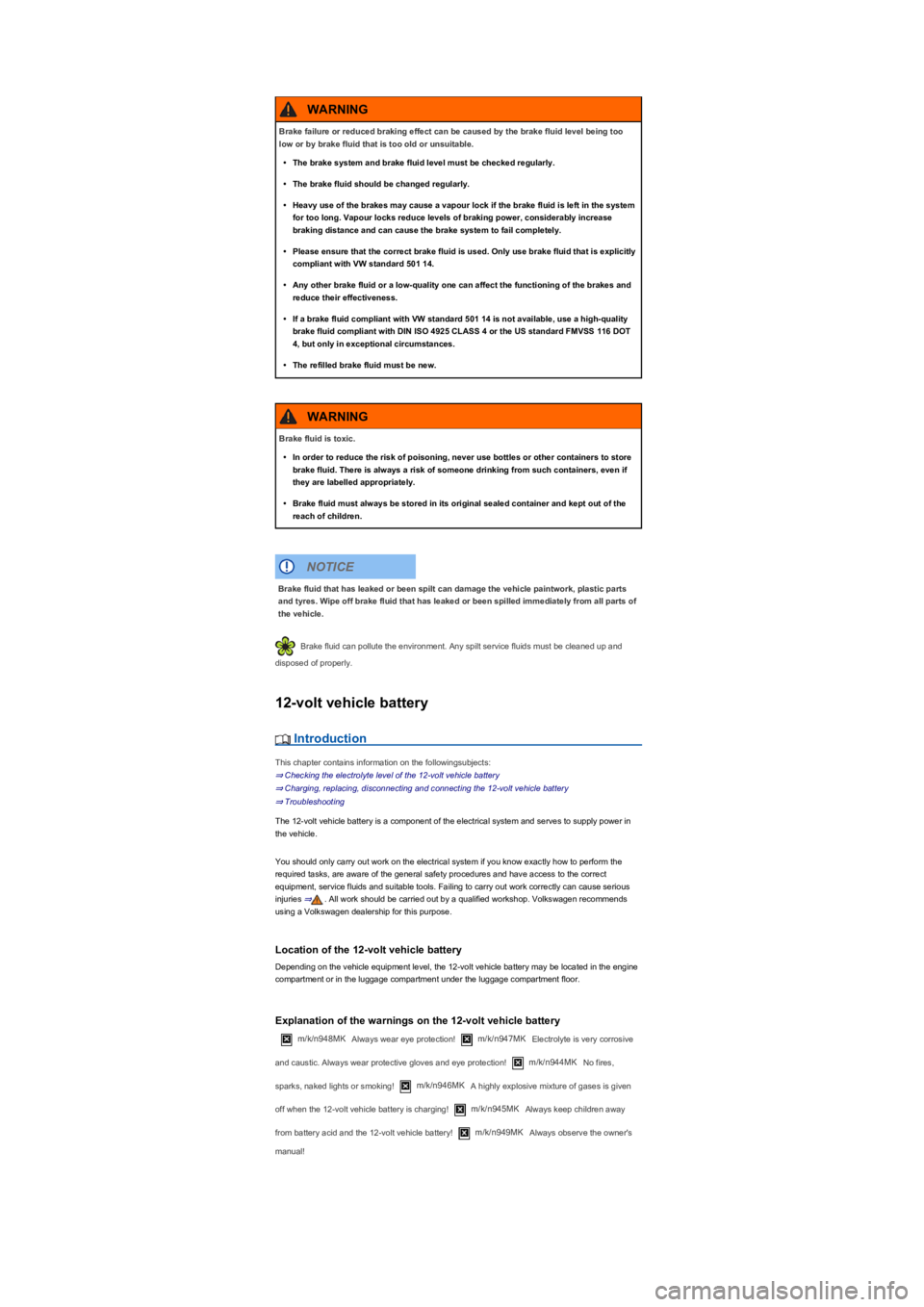
Brake fluid can pollute the environment. Any spilt service fluids must be cleaned up and
disposed of properly.
12-volt vehicle battery
Introduction
This chapter contains information on the followingsubjects:
⇒ Checking the electrolyte level of the 12-volt vehicle battery
⇒ Charging, replacing, disconnecting and connecting the 12-volt vehicle battery
⇒ Troubleshooting
The 12-volt vehicle battery is a component of the electrical system and serves to supply power in
the vehicle.
You should only carry out work on the electrical system if you know exactly how to perform the
required tasks, are aware of the general safety procedures and have access to the correct
equipment, service fluids and suitable tools. Failing to carry out work correctly can cause serious
injuries ⇒. All work should be carried out by a qualified workshop. Volkswagen recommends
using a Volkswagen dealership for this purpose.
Location of the 12-volt vehicle battery
Depending on the vehicle equipment level, the 12-volt vehicle battery may be located in the engine
compartment or in the luggage compartment under the luggage compartment floor.
Explanation of the warnings on the 12-volt vehicle battery
m/k/n948MKAlways wear eye protection!m/k/n947MKElectrolyte is very corrosive
and caustic. Always wear protective gloves and eye protection!m/k/n944MKNo fires,
sparks, naked lights or smoking!m/k/n946MKA highly explosive mixture of gases is given
off when the 12-volt vehicle battery is charging!m/k/n945MKAlways keep children away
from battery acid and the 12-volt vehicle battery!m/k/n949MKAlways observe the owner's
manual!
Brake failure or reduced braking effect can be caused by the brake fluid level being too
low or by brake fluid that is too old or unsuitable.
•The brake system and brake fluid level must be checked regularly.
•The brake fluid should be changed regularly.
•Heavy use of the brakes may cause a vapour lock if the brake fluid is left in the system
for too long. Vapour locks reduce levels of braking power, considerably increase
braking distance and can cause the brake system to fail completely.
•Please ensure that the correct brake fluid is used. Only use brake fluid that is explicitly
compliant with VW standard 501 14.
•Any other brake fluid or a low-quality one can affect the functioning of the brakes and
reduce their effectiveness.
•If a brake fluid compliant with VW standard 501 14 is not available, use a high-quality
brake fluid compliant with DIN ISO 4925 CLASS 4 or the US standard FMVSS 116 DOT
4, but only in exceptional circumstances.
•The refilled brake fluid must be new.
WARNING
Brake fluid is toxic.
•In order to reduce the risk of poisoning, never use bottles or other containers to store
brake fluid. There is always a risk of someone drinking from such containers, even if
they are labelled appropriately.
•Brake fluid must always be stored in its original sealed container and kept out of the
reach of children.
WARNING
Brake fluid that has leaked or been spilt can damage the vehicle paintwork, plastic parts
and tyres. Wipe off brake fluid that has leaked or been spilled immediately from all parts of
the vehicle.
NOTICE
Page 286 of 341
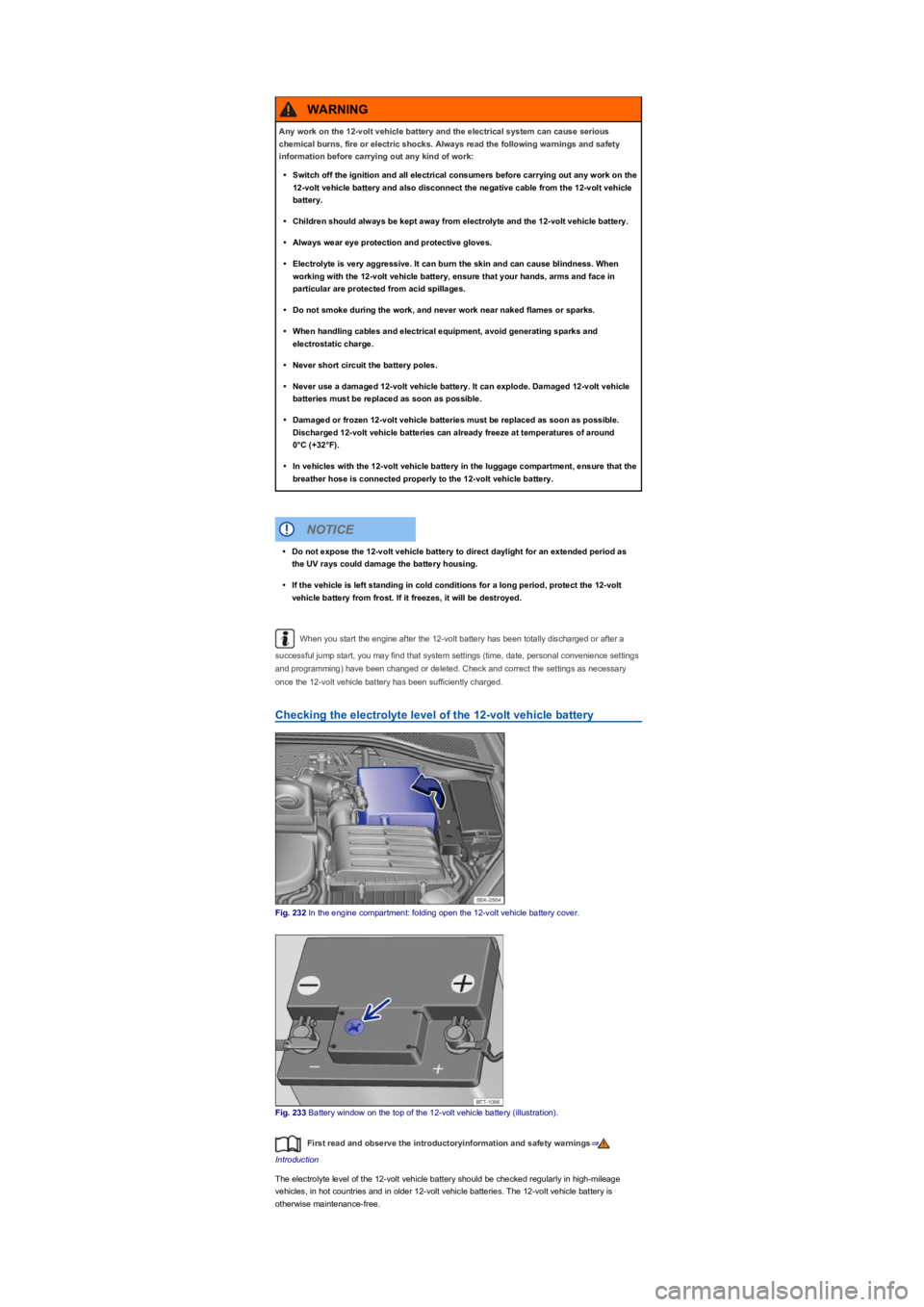
When you start the engine after the 12-volt battery has been totally discharged or after a
successful jump start, you may find that system settings (time, date, personal convenience settings
and programming) have been changed or deleted. Check and correct the settings as necessary
once the 12-volt vehicle battery has been sufficiently charged.
Checking the electrolyte level of the 12-volt vehicle battery
Fig. 232 In the engine compartment: folding open the 12-volt vehicle battery cover.
Fig. 233 Battery window on the top of the 12-volt vehicle battery (illustration).
First read and observe the introductoryinformation and safety warnings⇒
Introduction
The electrolyte level of the 12-volt vehicle battery should be checked regularly in high-mileage
vehicles, in hot countries and in older 12-volt vehicle batteries. The 12-volt vehicle battery is
otherwise maintenance-free.
Any work on the 12-volt vehicle battery and the electrical system can cause serious
chemical burns, fire or electric shocks. Always read the following warnings and safety
information before carrying out any kind of work:
•Switch off the ignition and all electrical consumers before carrying out any work on the
12-volt vehicle battery and also disconnect the negative cable from the 12-volt vehicle
battery.
•Children should always be kept away from electrolyte and the 12-volt vehicle battery.
•Always wear eye protection and protective gloves.
•Electrolyte is very aggressive. It can burn the skin and can cause blindness. When
working with the 12-volt vehicle battery, ensure that your hands, arms and face in
particular are protected from acid spillages.
•Do not smoke during the work, and never work near naked flames or sparks.
•When handling cables and electrical equipment, avoid generating sparks and
electrostatic charge.
•Never short circuit the battery poles.
•Never use a damaged 12-volt vehicle battery. It can explode. Damaged 12-volt vehicle
batteries must be replaced as soon as possible.
•Damaged or frozen 12-volt vehicle batteries must be replaced as soon as possible.
Discharged 12-volt vehicle batteries can already freeze at temperatures of around
0°C (+32°F).
•In vehicles with the 12-volt vehicle battery in the luggage compartment, ensure that the
breather hose is connected properly to the 12-volt vehicle battery.
WARNING
•Do not expose the 12-volt vehicle battery to direct daylight for an extended period as
the UV rays could damage the battery housing.
•If the vehicle is left standing in cold conditions for a long period, protect the 12-volt
vehicle battery from frost. If it freezes, it will be destroyed.
NOTICE
Page 287 of 341
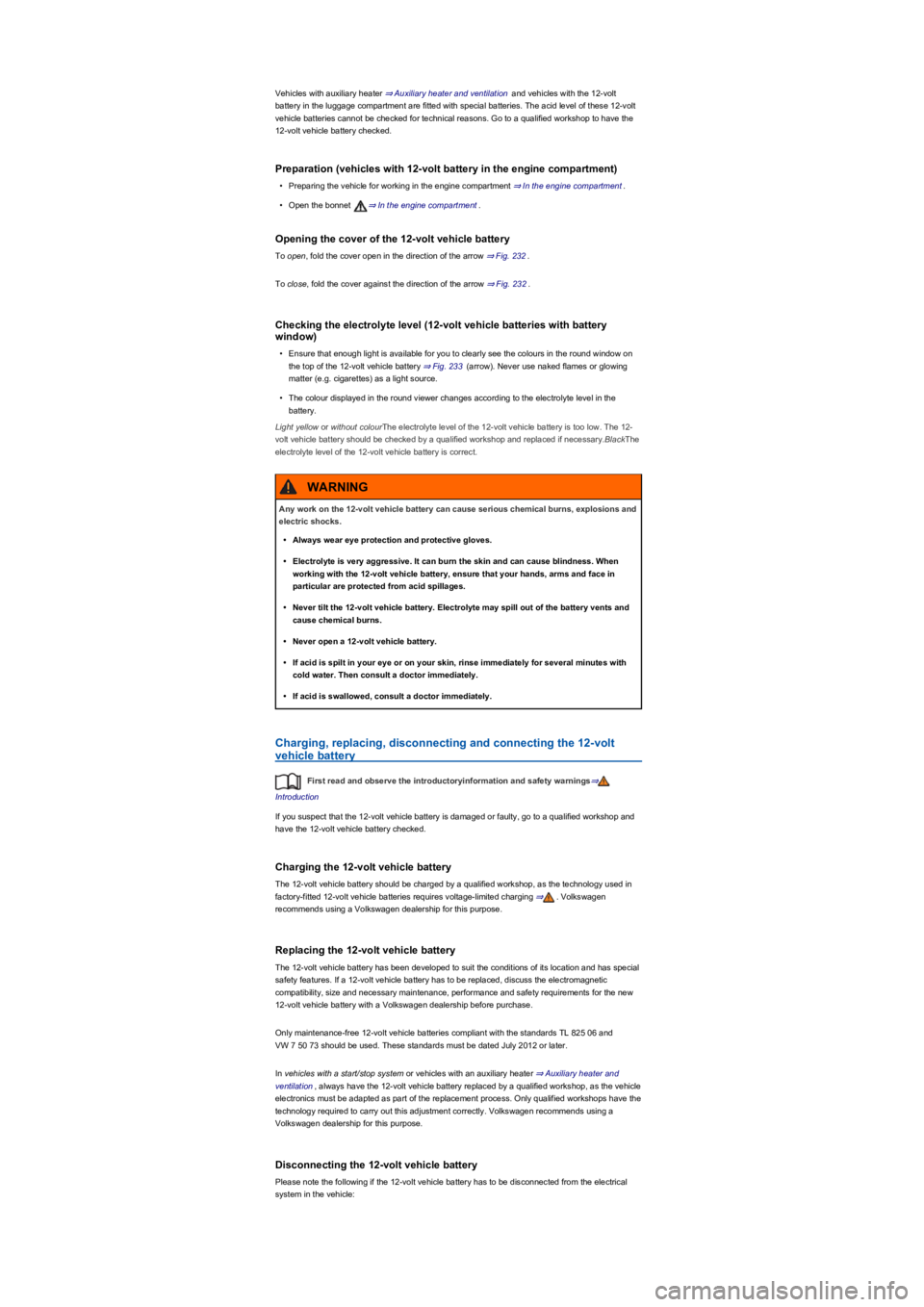
Vehicles with auxiliary heater ⇒ Auxiliary heater and ventilation and vehicles with the 12-volt
battery in the luggage compartment are fitted with special batteries. The acid level of these 12-volt
vehicle batteries cannot be checked for technical reasons. Go to a qualified workshop to have the
12-volt vehicle battery checked.
Preparation (vehicles with 12-volt battery in the engine compartment)
•Preparing the vehicle for working in the engine compartment ⇒ In the engine compartment.
•Open the bonnet ⇒ In the engine compartment.
Opening the cover of the 12-volt vehicle battery
To open, fold the cover open in the direction of the arrow ⇒ Fig. 232.
To close, fold the cover against the direction of the arrow ⇒ Fig. 232.
Checking the electrolyte level (12-volt vehicle batteries with battery
window)
•Ensure that enough light is available for you to clearly see the colours in the round window on
the top of the 12-volt vehicle battery ⇒ Fig. 233 (arrow). Never use naked flames or glowing
matter (e.g. cigarettes) as a light source.
•The colour displayed in the round viewer changes according to the electrolyte level in the
battery.
Light yellow or without colourThe electrolyte level of the 12-volt vehicle battery is too low. The 12-
volt vehicle battery should be checked by a qualified workshop and replaced if necessary.BlackThe
electrolyte level of the 12-volt vehicle battery is correct.
Charging, replacing, disconnecting and connecting the 12-volt
vehicle battery
First read and observe the introductoryinformation and safety warnings⇒
Introduction
If you suspect that the 12-volt vehicle battery is damaged or faulty, go to a qualified workshop and
have the 12-volt vehicle battery checked.
Charging the 12-volt vehicle battery
The 12-volt vehicle battery should be charged by a qualified workshop, as the technology used in
factory-fitted 12-volt vehicle batteries requires voltage-limited charging ⇒. Volkswagen
recommends using a Volkswagen dealership for this purpose.
Replacing the 12-volt vehicle battery
The 12-volt vehicle battery has been developed to suit the conditions of its location and has special
safety features. If a 12-volt vehicle battery has to be replaced, discuss the electromagnetic
compatibility, size and necessary maintenance, performance and safety requirements for the new
12-volt vehicle battery with a Volkswagen dealership before purchase.
Only maintenance-free 12-volt vehicle batteries compliant with the standards TL 825 06 and
VW 7 50 73 should be used. These standards must be dated July 2012 or later.
In vehicles with a start/stop system or vehicles with an auxiliary heater ⇒ Auxiliary heater and
ventilation, always have the 12-volt vehicle battery replaced by a qualified workshop, as the vehicle
electronics must be adapted as part of the replacement process. Only qualified workshops have the
technology required to carry out this adjustment correctly. Volkswagen recommends using a
Volkswagen dealership for this purpose.
Disconnecting the 12-volt vehicle battery
Please note the following if the 12-volt vehicle battery has to be disconnected from the electrical
system in the vehicle:
Any work on the 12-volt vehicle battery can cause serious chemical burns, explosions and
electric shocks.
•Always wear eye protection and protective gloves.
•Electrolyte is very aggressive. It can burn the skin and can cause blindness. When
working with the 12-volt vehicle battery, ensure that your hands, arms and face in
particular are protected from acid spillages.
•Never tilt the 12-volt vehicle battery. Electrolyte may spill out of the battery vents and
cause chemical burns.
•Never open a 12-volt vehicle battery.
•If acid is spilt in your eye or on your skin, rinse immediately for several minutes with
cold water. Then consult a doctor immediately.
•If acid is swallowed, consult a doctor immediately.
WARNING
Page 288 of 341
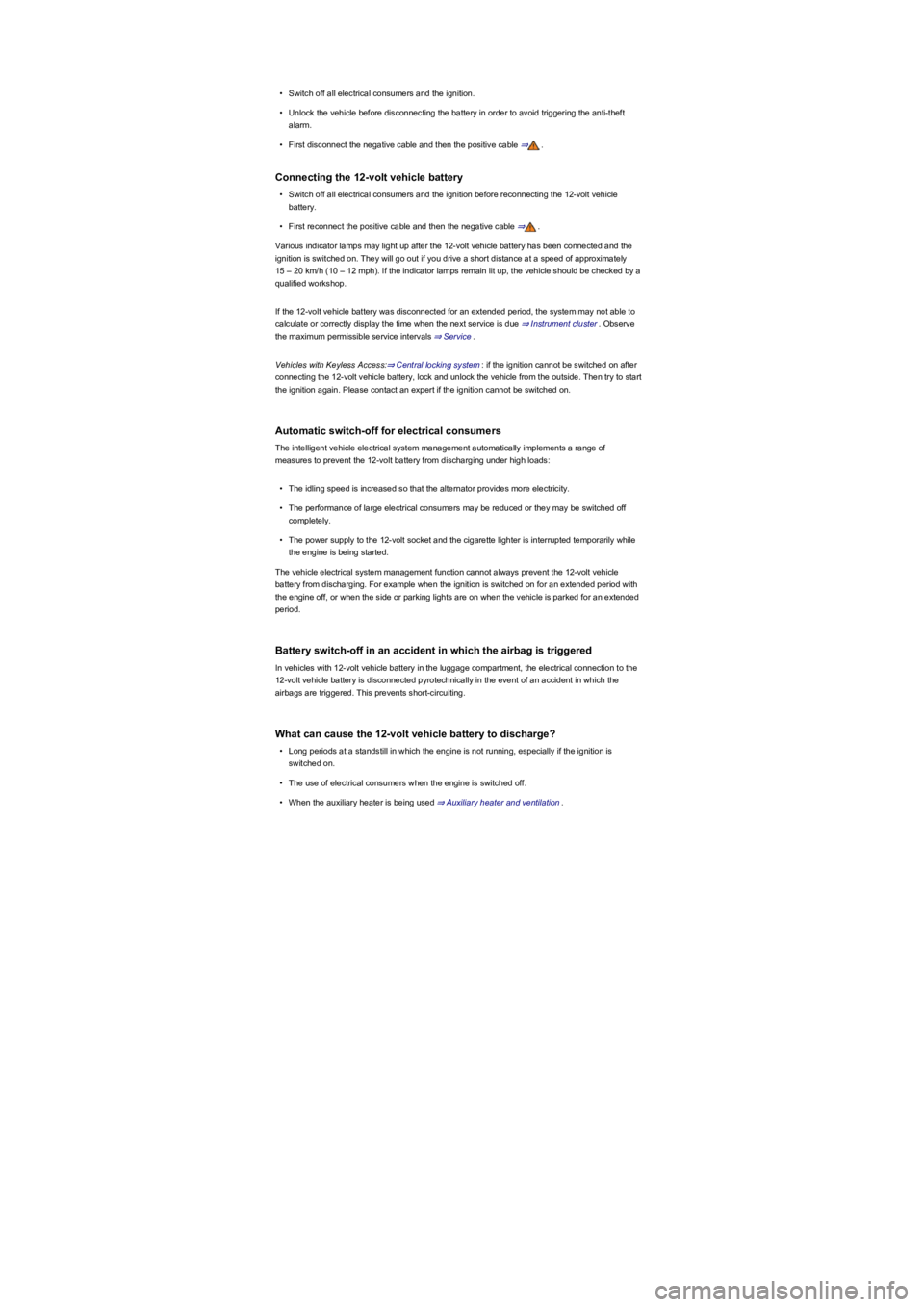
•Switch off all electrical consumers and the ignition.
•Unlock the vehicle before disconnecting the battery in order to avoid triggering the anti-theft
alarm.
•First disconnect the negative cable and then the positive cable ⇒.
Connecting the 12-volt vehicle battery
•Switch off all electrical consumers and the ignition before reconnecting the 12-volt vehicle
battery.
•First reconnect the positive cable and then the negative cable ⇒.
Various indicator lamps may light up after the 12-volt vehicle battery has been connected and the
ignition is switched on. They will go out if you drive a short distance at a speed of approximately
15 – 20 km/h (10 – 12 mph). If the indicator lamps remain lit up, the vehicle should be checked by a
qualified workshop.
If the 12-volt vehicle battery was disconnected for an extended period, the system may not able to
calculate or correctly display the time when the next service is due ⇒ Instrument cluster. Observe
the maximum permissible service intervals ⇒ Service.
Vehicles with Keyless Access:⇒ Central locking system: if the ignition cannot be switched on after
connecting the 12-volt vehicle battery, lock and unlock the vehicle from the outside. Then try to start
the ignition again. Please contact an expert if the ignition cannot be switched on.
Automatic switch-off for electrical consumers
The intelligent vehicle electrical system management automatically implements a range of
measures to prevent the 12-volt battery from discharging under high loads:
•The idling speed is increased so that the alternator provides more electricity.
•The performance of large electrical consumers may be reduced or they may be switched off
completely.
•The power supply to the 12-volt socket and the cigarette lighter is interrupted temporarily while
the engine is being started.
The vehicle electrical system management function cannot always prevent the 12-volt vehicle
battery from discharging. For example when the ignition is switched on for an extended period with
the engine off, or when the side or parking lights are on when the vehicle is parked for an extended
period.
Battery switch-off in an accident in which the airbag is triggered
In vehicles with 12-volt vehicle battery in the luggage compartment, the electrical connection to the
12-volt vehicle battery is disconnected pyrotechnically in the event of an accident in which the
airbags are triggered. This prevents short-circuiting.
What can cause the 12-volt vehicle battery to discharge?
•Long periods at a standstill in which the engine is not running, especially if the ignition is
switched on.
•The use of electrical consumers when the engine is switched off.
•When the auxiliary heater is being used ⇒ Auxiliary heater and ventilation.
Page 289 of 341
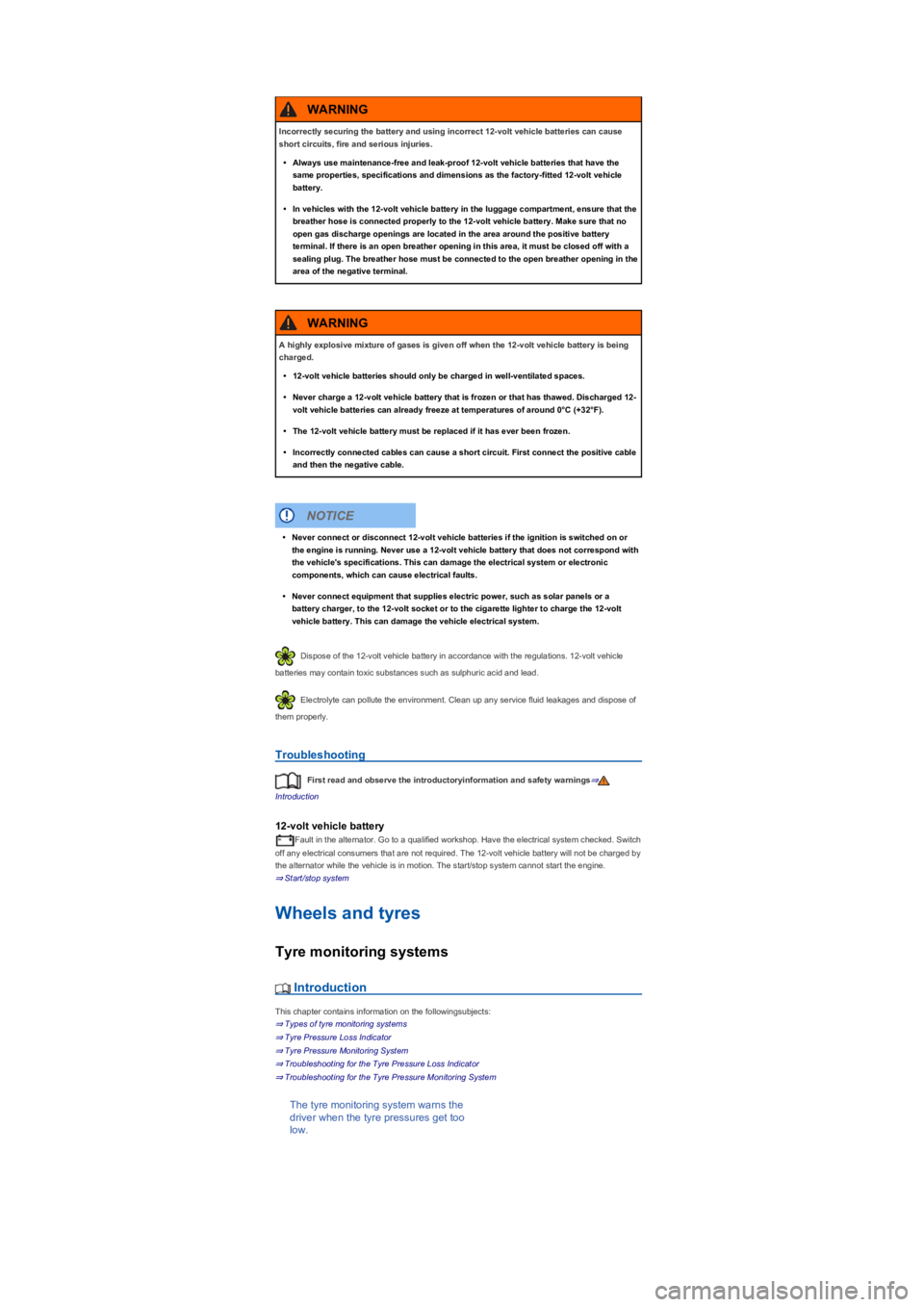
Dispose of the 12-volt vehicle battery in accordance with the regulations. 12-volt vehicle
batteries may contain toxic substances such as sulphuric acid and lead.
Electrolyte can pollute the environment. Clean up any service fluid leakages and dispose of
them properly.
Troubleshooting
First read and observe the introductoryinformation and safety warnings⇒
Introduction
12-volt vehicle battery
Fault in the alternator. Go to a qualified workshop. Have the electrical system checked. Switch
off any electrical consumers that are not required. The 12-volt vehicle battery will not be charged by
the alternator while the vehicle is in motion. The start/stop system cannot start the engine.
⇒ Start/stop system
Wheels and tyres
Tyre monitoring systems
Introduction
This chapter contains information on the followingsubjects:
⇒ Types of tyre monitoring systems
⇒ Tyre Pressure Loss Indicator
⇒ Tyre Pressure Monitoring System
⇒ Troubleshooting for the Tyre Pressure Loss Indicator
⇒ Troubleshooting for the Tyre Pressure Monitoring System
The tyre monitoring system warns the
driver when the tyre pressures get too
low.
Incorrectly securing the battery and using incorrect 12-volt vehicle batteries can cause
short circuits, fire and serious injuries.
•Always use maintenance-free and leak-proof 12-volt vehicle batteries that have the
same properties, specifications and dimensions as the factory-fitted 12-volt vehicle
battery.
•In vehicles with the 12-volt vehicle battery in the luggage compartment, ensure that the
breather hose is connected properly to the 12-volt vehicle battery. Make sure that no
open gas discharge openings are located in the area around the positive battery
terminal. If there is an open breather opening in this area, it must be closed off with a
sealing plug. The breather hose must be connected to the open breather opening in the
area of the negative terminal.
WARNING
A highly explosive mixture of gases is given off when the 12-volt vehicle battery is being
charged.
•12-volt vehicle batteries should only be charged in well-ventilated spaces.
•Never charge a 12-volt vehicle battery that is frozen or that has thawed. Discharged 12-
volt vehicle batteries can already freeze at temperatures of around 0°C (+32°F).
•The 12-volt vehicle battery must be replaced if it has ever been frozen.
•Incorrectly connected cables can cause a short circuit. First connect the positive cable
and then the negative cable.
WARNING
•Never connect or disconnect 12-volt vehicle batteries if the ignition is switched on or
the engine is running. Never use a 12-volt vehicle battery that does not correspond with
the vehicle's specifications. This can damage the electrical system or electronic
components, which can cause electrical faults.
•Never connect equipment that supplies electric power, such as solar panels or a
battery charger, to the 12-volt socket or to the cigarette lighter to charge the 12-volt
vehicle battery. This can damage the vehicle electrical system.
NOTICE
Page 290 of 341
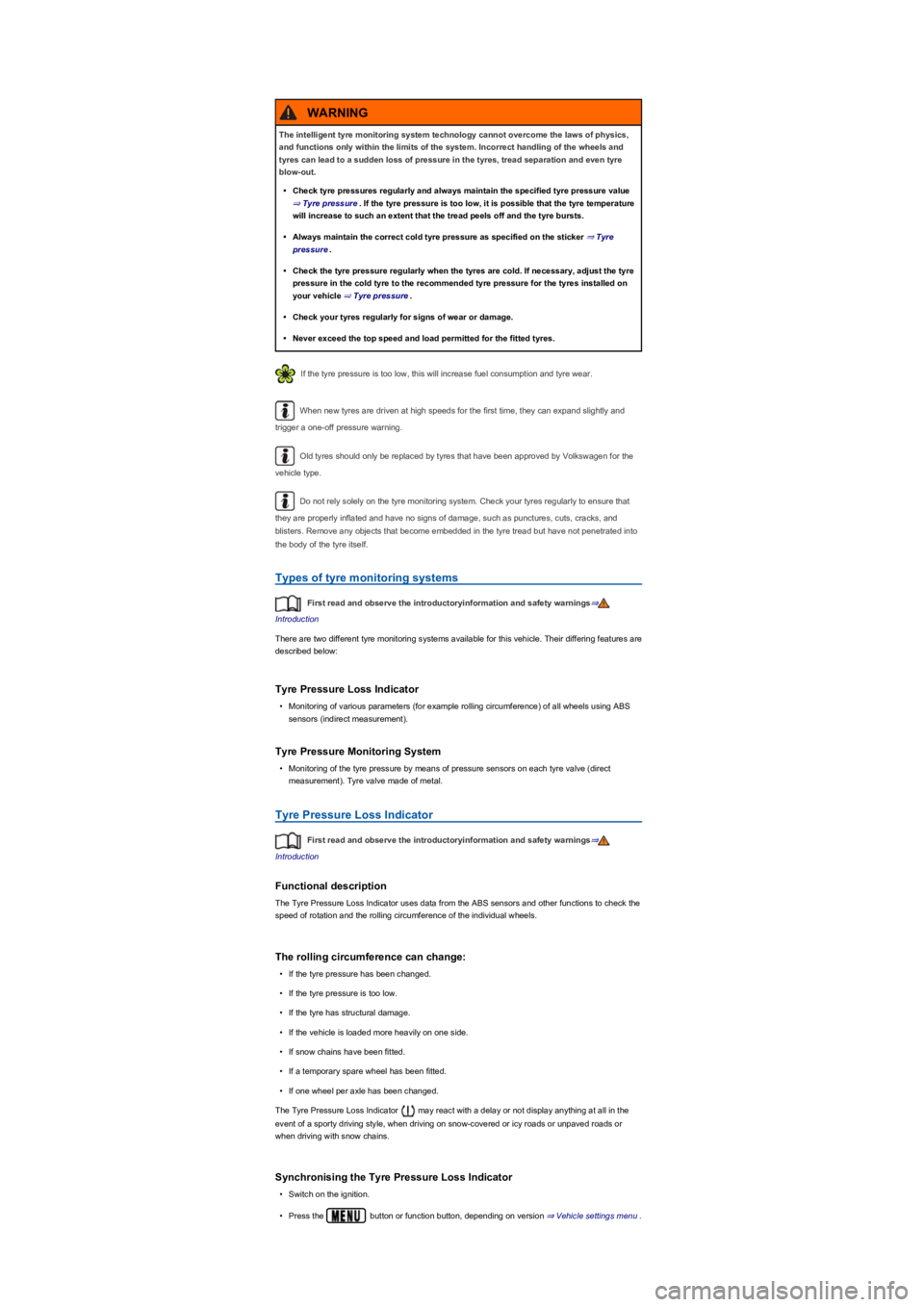
If the tyre pressure is too low, this will increase fuel consumption and tyre wear.
When new tyres are driven at high speeds for the first time, they can expand slightly and
trigger a one-off pressure warning.
Old tyres should only be replaced by tyres that have been approved by Volkswagen for the
vehicle type.
Do not rely solely on the tyre monitoring system. Check your tyres regularly to ensure that
they are properly inflated and have no signs of damage, such as punctures, cuts, cracks, and
blisters. Remove any objects that become embedded in the tyre tread but have not penetrated into
the body of the tyre itself.
Types of tyre monitoring systems
First read and observe the introductoryinformation and safety warnings⇒
Introduction
There are two different tyre monitoring systems available for this vehicle. Their differing features are
described below:
Tyre Pressure Loss Indicator
•Monitoring of various parameters (for example rolling circumference) of all wheels using ABS
sensors (indirect measurement).
Tyre Pressure Monitoring System
•Monitoring of the tyre pressure by means of pressure sensors on each tyre valve (direct
measurement). Tyre valve made of metal.
Tyre Pressure Loss Indicator
First read and observe the introductoryinformation and safety warnings⇒
Introduction
Functional description
The Tyre Pressure Loss Indicator uses data from the ABS sensors and other functions to check the
speed of rotation and the rolling circumference of the individual wheels.
The rolling circumference can change:
•If the tyre pressure has been changed.
•If the tyre pressure is too low.
•If the tyre has structural damage.
•If the vehicle is loaded more heavily on one side.
•If snow chains have been fitted.
•If a temporary spare wheel has been fitted.
•If one wheel per axle has been changed.
The Tyre Pressure Loss Indicator may react with a delay or not display anything at all in the
event of a sporty driving style, when driving on snow-covered or icy roads or unpaved roads or
when driving with snow chains.
Synchronising the Tyre Pressure Loss Indicator
•Switch on the ignition.
•Press the button or function button, depending on version ⇒ Vehicle settings menu.
The intelligent tyre monitoring system technology cannot overcome the laws of physics,
and functions only within the limits of the system. Incorrect handling of the wheels and
tyres can lead to a sudden loss of pressure in the tyres, tread separation and even tyre
blow-out.
•Check tyre pressures regularly and always maintain the specified tyre pressure value
⇒ Tyre pressure. If the tyre pressure is too low, it is possible that the tyre temperature
will increase to such an extent that the tread peels off and the tyre bursts.
•Always maintain the correct cold tyre pressure as specified on the sticker ⇒ Tyre
pressure.
•Check the tyre pressure regularly when the tyres are cold. If necessary, adjust the tyre
pressure in the cold tyre to the recommended tyre pressure for the tyres installed on
your vehicle ⇒ Tyre pressure.
•Check your tyres regularly for signs of wear or damage.
•Never exceed the top speed and load permitted for the fitted tyres.
WARNING